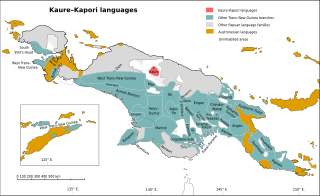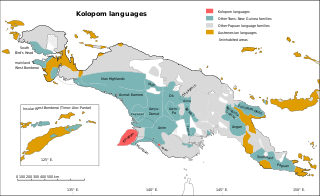Related Research Articles

The Papuan languages are the non-Austronesian languages spoken on the western Pacific island of New Guinea, as well as neighbouring islands in Indonesia, Solomon Islands, and East Timor. It is a strictly geographical grouping, and does not imply a genetic relationship.
The Foja Range languages, or Tor–Kwerba in more limited scope, are a family of about two dozen Papuan languages. They are named after the Foja Mountains of western New Guinea.
The Lakes Plain languages are a family of Papuan languages, spoken in the Lakes Plain of Indonesian New Guinea. They are notable for being heavily tonal and for their lack of nasal consonants.
Isirawa is a Papuan language spoken by about two thousand people on the north coast of Papua province, Indonesia. It's a local trade language, and use is vigorous. Stephen Wurm (1975) linked it to the Kwerba languages within the Trans–New Guinea family, and it does share about 20% of its vocabulary with neighboring Kwerba languages. However, based on its pronouns, Malcolm Ross (2005) felt he could not substantiate such a link, and left it as a language isolate. The pronouns are not, however, dissimilar from those of Orya–Tor, which Ross links to Kwerba, and Donahue (2002) accept it as a Greater Kwerba language.
The Burmeso language – also known as Taurap – is spoken by some 300 people in Burmeso village along the mid Mamberamo River in Mamberamo Tengah subdistrict, Mamberamo Raya Regency, Papua province, Indonesia. It is surrounded by the Kwerba languages to the north, the Lakes Plain languages to the south, and the East Cenderawasih Bay languages to the west.

The Kaure–Kosare or Nawa River languages are a small family spoken along the Nawa River in West Papua, near the northern border with Papua New Guinea. The languages are Kaure and Kosare.
Momuna (Momina), also known as Somahai, is a Papuan language spoken in Yahukimo Regency, Highland Papua and Asmat Regency, South Papua, Indonesia.

The Kolopom languages are a family of Trans–New Guinea languages in the classifications of Stephen Wurm (1975) and of Malcolm Ross (2005). Along with the Mombum languages, they are the languages spoken on Kolepom Island in South Papua, Indonesia.
The Demta–Sentani languages form a language family of coastal Indonesian Papua near the Papua New Guinea border.
Mpur is a language isolate spoken in and around Mpur and Amberbaken Districts in Tambrauw Regency of the Bird's Head Peninsula, New Guinea. It is not closely related to any other language, and though Ross (2005) tentatively assigned it to the West Papuan languages, based on similarities in pronouns, Palmer (2018), Ethnologue, and Glottolog list it as a language isolate.

Morori is a moribund Papuan language of the Kolopom branch of the Trans–New Guinea family. It is separated from the other Kolopom languages by the intrusive Marind family. All speakers use Papuan Malay or Indonesian as L2, and many know Marind.

Mor is a nearly extinct Trans–New Guinea language of Indonesia. It is spoken along the Budidi River and the Bomberai River on the Bomberai Peninsula.
The Orya–Tor languages are a family of just over a dozen Papuan languages spoken in Western New Guinea, Indonesia.
Molof is a poorly documented Papuan language spoken by about 200 people in Molof village, Senggi District, Keerom Regency.
Tofanma or Tofamna is a poorly documented Papuan language of Indonesia. Wurm (1975) placed it as an independent branch of Trans–New Guinea, but Ross (2005) could not find enough evidence to classify it. It appears to be related to Namla, a neighboring language.
Keuw is an unclassified language of New Guinea.
Yetfa and Biksi are dialects of a language spoken in Jetfa District, Pegunungan Bintang Regency, Highland Papua, Indonesia, and across the border in Papua New Guinea. It is a trade language spoken in Western New Guinea up to the PNG border.
Edolo (Etoro) is a Papuan language of Papua New Guinea, spoken by the Etoro people. As of 2015, there were 300 monolingual speakers. It is part of the Bosavi branch of the Trans–New Guinea language family.
The Kwerbic, or Greater Kwerba, languages are a family of just under a dozen Papuan languages spoken in Indonesia.
The Northwest Papuan languages are a proposed language family of Papuan languages.
References
- ↑ Orya at Ethnologue (25th ed., 2022)

- 1 2 Foley, William A. (2018). "The languages of Northwest New Guinea". In Palmer, Bill (ed.). The Languages and Linguistics of the New Guinea Area: A Comprehensive Guide. The World of Linguistics. Vol. 4. Berlin: De Gruyter Mouton. pp. 433–568. ISBN 978-3-11-028642-7.